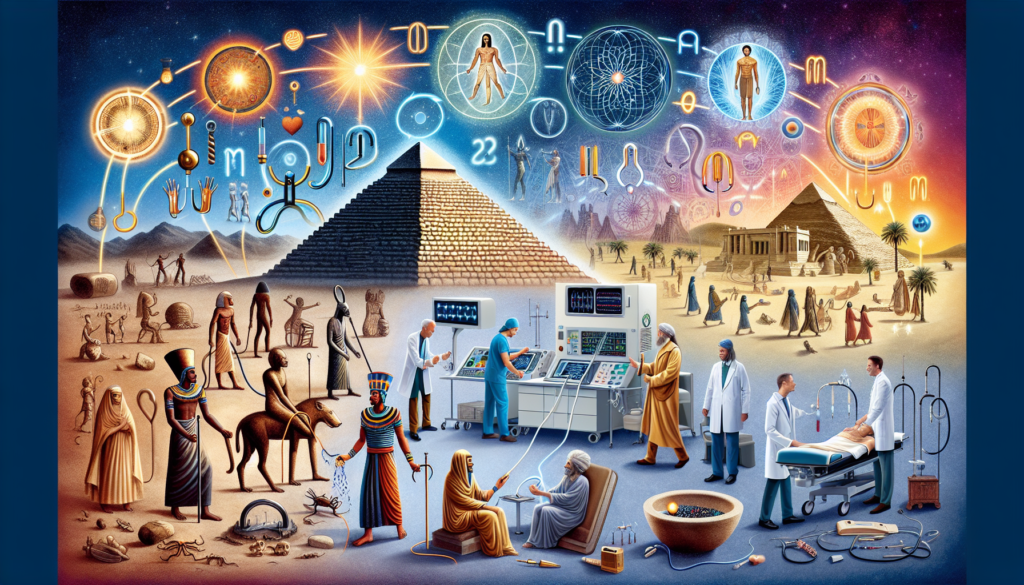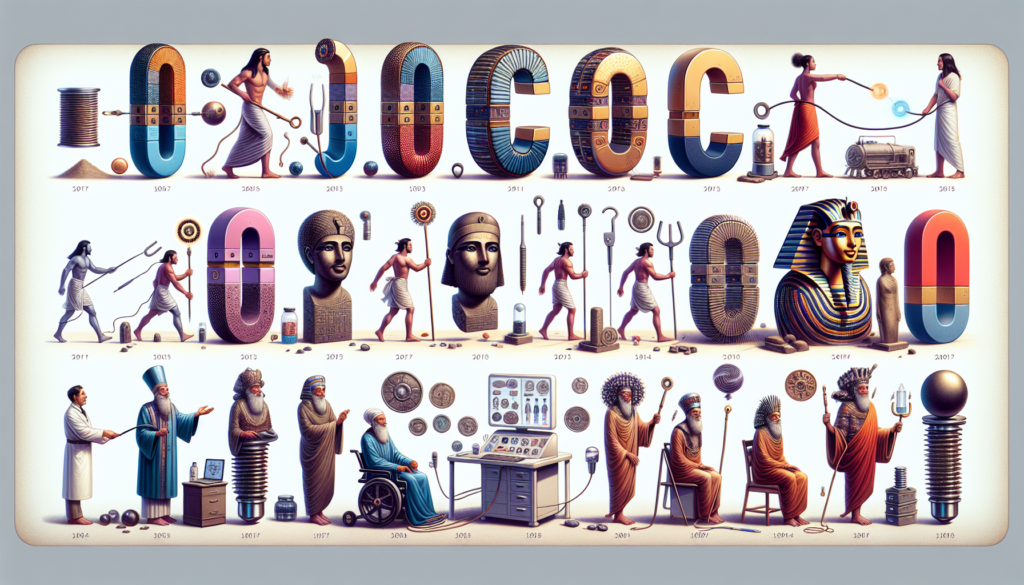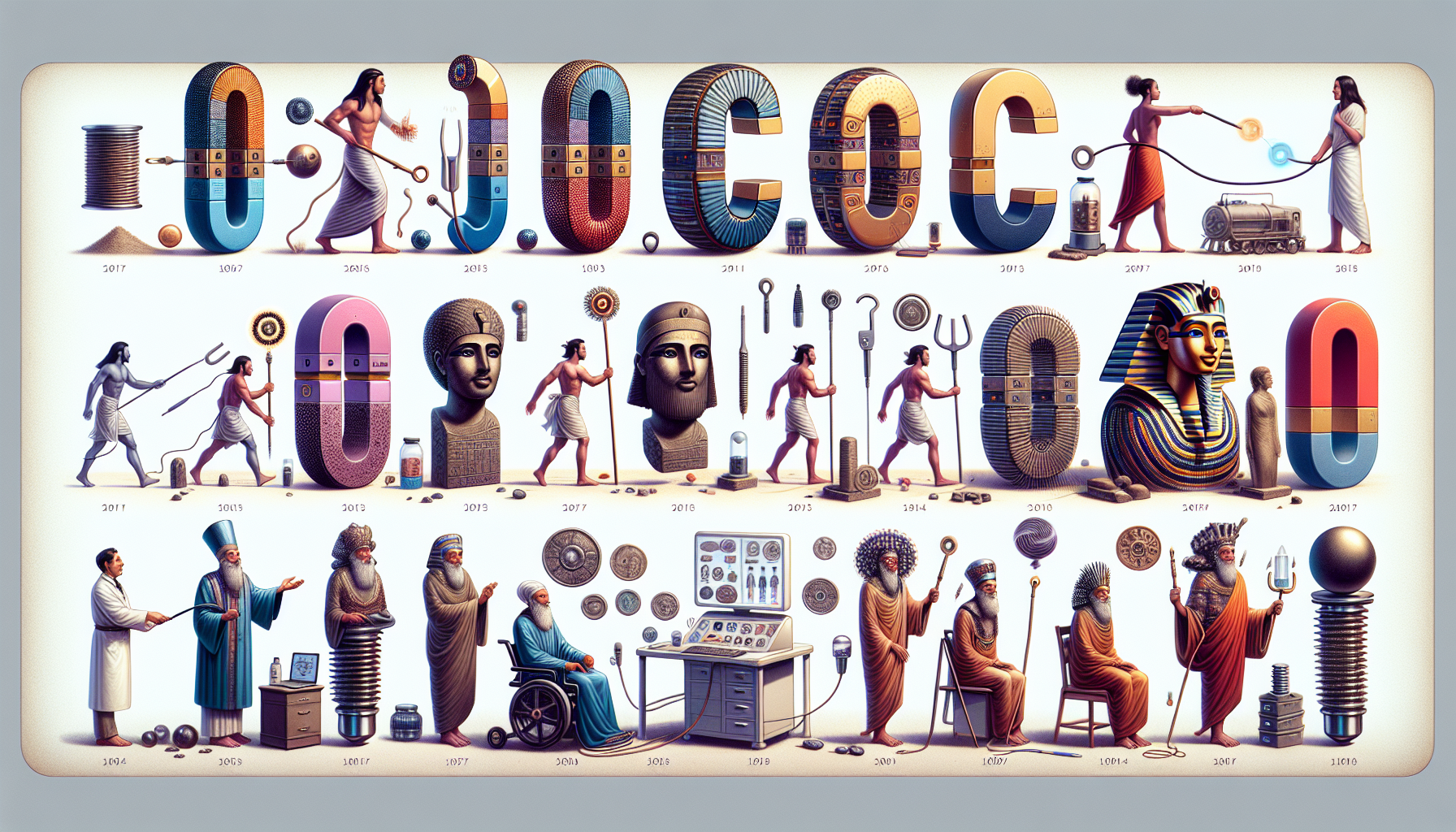Imagine experiencing pain relief, improved sleep, and enhanced overall well-being, all through the power of electromagnetic fields. This groundbreaking treatment, known as PEMF (Pulsed Electromagnetic Field) therapy, has a rich and fascinating history that stretches far back into ancient times and continues to evolve today. From the use of lodestones by ancient Egyptians to the revolutionary advancements in technology, this article takes you on a captivating journey through the centuries, exploring the origins, developments, and current applications of PEMF treatment. Get ready to delve into the intriguing world of PEMF therapy and discover how it has transformed lives throughout history.
Ancient Times
Early Discoveries of Electromagnetic Properties
In ancient times, the understanding and use of electromagnetic properties were limited, but there were some early discoveries that laid the foundation for future advancements. Civilizations such as the Egyptians, Chinese, Greeks, and Romans made significant contributions to this field.
Ancient Egyptian Use of Magnetic Therapy
The ancient Egyptians were one of the first civilizations to recognize and utilize the healing properties of magnets. They believed that magnets had the power to restore balance and harmony within the body. Magnetic therapy was used to alleviate various ailments, including pain, inflammation, and even mental disorders. The Egyptians also used magnetic stones in jewelry and cosmetics, believing that they could enhance beauty and well-being.
Chinese Use of Magnetic Stones
Similarly, the Chinese also recognized the therapeutic properties of magnetic stones. They believed in the concept of qi (energy flow) within the body and its impact on health. By placing magnets on specific acupuncture points, it was believed that the magnetic fields could rebalance the qi and promote healing. This practice, known as magnetotherapy, was widely used in traditional Chinese medicine.
Greek and Roman Experimentation with Magnetism
In ancient Greece and Rome, scholars and physicians also delved into the study of magnetism. The Greek philosopher Thales of Miletus observed the interactions between magnets and discovered that certain stones, when rubbed with amber, could attract lightweight objects. The Roman philosopher and naturalist Pliny the Elder further documented the healing properties of magnets, emphasizing their ability to relieve pain and improve general well-being.
Middle Ages
Magnetic Healing Practices in Medieval Europe
During the Middle Ages, the knowledge and use of electromagnetic therapy continued, albeit with a shift towards religious and spiritual connotations. Magnets became associated with miracles and supernatural healing, with the belief that their power was derived from divine intervention. Magnetic amulets and talismans were commonly worn and attributed with mystical healing properties.
Paracelsus and His Contributions to Electromagnetic Therapy
One of the key figures in electromagnetic therapy during the Middle Ages was the Swiss physician and alchemist, Paracelsus. He rejected the prevailing beliefs of his time and proposed a more scientific approach to medicine. Paracelsus experimented with magnets, believing that they could influence the body’s vital energy. He introduced the concept of “magnetismus” and advocated for the use of magnets in medical treatments.

Renaissance and Enlightenment
Magnetic Therapy in the 16th and 17th Centuries
The Renaissance period saw a renewed interest in the study of magnetism and its potential therapeutic applications. Physicians and scientists conducted experiments and published treatises on the subject. Magnetic therapy became particularly popular in England and France during the 16th and 17th centuries, with the establishment of dedicated clinics and hospitals for magnetic treatments.
Franz Anton Mesmer and Animal Magnetism
One of the most influential figures in the history of electromagnetic therapy was the Austrian physician Franz Anton Mesmer. Mesmer developed a theory known as “animal magnetism,” which proposed that the body’s health was governed by invisible magnetic forces. He believed that by manipulating these forces, he could induce healing. Mesmer’s methods, which involved the use of magnets and mesmerizing techniques, gained widespread attention and controversy.
The Development of Electromagnetic Machines
During the Enlightenment period, there were significant advancements in the development of electromagnetic machines for therapeutic use. Scientists and inventors, such as Benjamin Franklin and Luigi Galvani, made groundbreaking discoveries in the field of electromagnetism. These discoveries paved the way for the invention of various electromagnetic devices, some of which were used for medical treatments.
19th Century
Faraday and the Laws of Electromagnetic Induction
In the 19th century, the scientific understanding of electromagnetism expanded significantly. Michael Faraday, an English scientist, formulated the laws of electromagnetic induction, which laid the foundation for the development of electromagnetic therapy. Faraday’s experiments with magnetic fields and electric currents paved the way for future advancements in this field.
The Emergence of Electromagnetic Therapy
The 19th century witnessed the emergence of electromagnetic therapy as a recognized medical practice. Electrical devices were used to deliver therapeutic currents to patients, treating various conditions such as paralysis, neuralgia, and rheumatism. Electromagnetic therapy gained popularity, and specialized clinics were established in Europe and America to offer these treatments.
The Influence of Alternative Medicine Movements
During the 19th century, alternative medicine movements, such as homeopathy and naturopathy, incorporated electromagnetic therapy into their treatment modalities. Advocates of these movements believed in the body’s inherent healing power and saw electromagnetic therapy as a way to stimulate that healing process. As a result, the use of electromagnetic devices became widespread within these alternative medicine communities.

Early 20th Century
Royal Rife and His Frequency Healing Devices
In the early 20th century, Royal Rife, an American inventor, introduced frequency healing devices as a form of electromagnetic therapy. Rife believed that specific frequencies could destroy harmful microorganisms and restore health. His inventions, such as the Rife Machine, garnered attention and controversy within the medical community.
The Invention of Diathermy Machines
Diathermy machines, which utilize electromagnetic waves to generate heat within the body, were invented in the early 20th century. These machines were primarily used for therapeutic purposes, such as relieving pain and promoting tissue healing. Diathermy gained popularity and was widely used in medical settings.
Electromagnetic Therapy in World War I
During World War I, the uses of electromagnetic therapy expanded, particularly in the field of battlefield medicine. Electromagnetic devices were used for the treatment of soldiers with various injuries, including fractures, wounds, and nerve damage. This marked a significant turning point in the recognition and acceptance of electromagnetic therapy within conventional medicine.
Mid-20th Century
Nikola Tesla and His Contributions to Electromagnetic Therapy
Nikola Tesla, a Serbian-American inventor, made significant contributions to the field of electromagnetic therapy in the mid-20th century. Tesla’s experiments with high-frequency currents and electromagnetic fields paved the way for advancements in this field. Although Tesla’s work did not receive widespread recognition during his lifetime, his inventions laid the foundation for future developments in electromagnetic therapy.
The Introduction of Pulsed Electromagnetic Fields
In the mid-20th century, pulsed electromagnetic fields (PEMF) gained attention and heralded a new era in electromagnetic therapy. PEMF devices delivered short bursts of electromagnetic fields to specific body areas, promoting tissue regeneration and healing. The introduction of PEMF brought about significant advancements in medical treatments and rehabilitation therapies.
Early Research and Clinical Applications of PEMF
As the understanding of PEMF grew, research and clinical applications expanded. PEMF was found to have positive effects on various health conditions, including bone healing, pain management, and wound healing. Clinical trials and studies reinforced the efficacy of PEMF, leading to its integration into mainstream medical treatments.
Late 20th Century
Advancements in PEMF Technology
In the late 20th century, advancements in technology allowed for the development of more sophisticated and targeted PEMF devices. These devices became smaller, portable, and adjustable, enabling patients to receive PEMF treatments in their homes. The accessibility and convenience of PEMF therapy increased significantly during this time.
The Discovery of NASA’s Role in PEMF
During the late 20th century, it was discovered that NASA had been conducting research on PEMF. NASA’s studies explored the effects of PEMF on astronauts’ health in space. The research findings not only validated the therapeutic potential of PEMF but also highlighted its ability to enhance tissue repair and reduce inflammation.
Growing Popularity of PEMF in Sports Medicine
PEMF gained popularity in the field of sports medicine during the late 20th century. Athletes and sports professionals began using PEMF devices for injury recovery, pain management, and performance enhancement. The non-invasive nature of PEMF and its potential for accelerating healing made it a valuable tool in the athletic community.
21st Century
Ongoing Research and Medical Applications of PEMF
In the 21st century, research on PEMF continues to expand, exploring its potential applications in various medical fields. Ongoing studies focus on the use of PEMF for conditions like arthritis, neurological disorders, and mental health. With advances in technology and scientific understanding, the medical community is uncovering new ways to harness the power of PEMF.
Integration of PEMF in Conventional Medicine
The integration of PEMF into conventional medicine is gradually increasing. PEMF devices are now used in hospitals, clinics, and rehabilitation centers as complementary treatments for a wide range of medical conditions. Physicians are recognizing the benefits of PEMF in pain management, wound healing, and post-surgical recovery.
Future Potential of PEMF
The future potential of PEMF therapy is promising. With ongoing research and technological advancements, the efficacy and applications of PEMF are likely to expand further. The development of personalized PEMF treatments based on individual needs and conditions holds great potential in revolutionizing the field of medicine.
Current Challenges and Limitations
Lack of Standardization and Regulation
One of the current challenges in the field of PEMF therapy is the lack of standardization and regulation. As the popularity of PEMF devices increases, there is a need for standardized treatment protocols, dosages, and safety guidelines. Without proper regulation, there is a risk of misuse and potential harm to patients.
Controversies and Debates Surrounding PEMF
The use of PEMF has faced controversies and debates within the medical community. Some skeptics question the scientific basis of PEMF and its effectiveness. Despite advancements in research, there is still a need for further studies to address these concerns and provide conclusive evidence of its efficacy.
Financial Accessibility of PEMF Treatment
Another limitation of PEMF therapy is its financial accessibility. While the cost of PEMF devices has decreased over time, they can still be expensive for individuals seeking long-term treatment. The availability of affordable and accessible PEMF devices remains a challenge, particularly for those without adequate insurance coverage.
Conclusion
From ancient times to the modern day, the history of PEMF treatment has been characterized by curiosity, experimentation, and advancements in science and technology. Starting with early discoveries of electromagnetic properties in ancient civilizations, the field of electromagnetic therapy has evolved and gained recognition over the centuries. The contributions of individuals such as Paracelsus, Mesmer, Faraday, and Tesla have paved the way for the integration of PEMF into conventional medicine. As ongoing research continues to explore the potential of PEMF in various medical fields, the future holds great promise for this innovative therapy. However, challenges such as standardization, regulation, controversies, and financial accessibility must be addressed to ensure the responsible and beneficial use of PEMF in healthcare. With continued advancements and collaborations between researchers, healthcare professionals, and manufacturers, the history and future of PEMF treatment are undoubtedly filled with potential.

